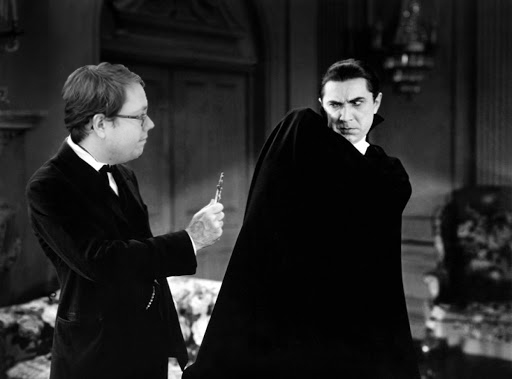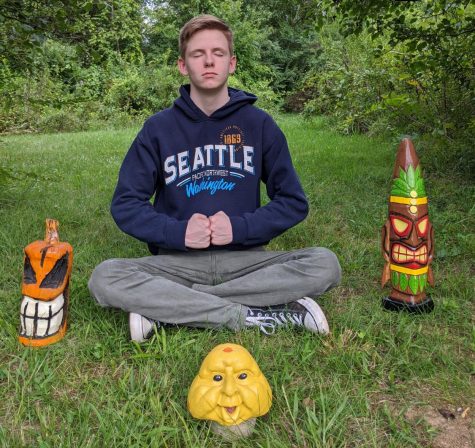A History of Horror
October 23, 2020
Most of us love scary movies. Whether it’s for the heart-pumping thrills or the disturbing creatures, or maybe even the gore, these dark stories keep us entertained and awake, especially at this time of the year. But where did the genre begin? Was it always so scary? What has changed?
The earliest of horror films were inspired by literature from authors such as Bram Stoker, Mary Shelley, and Edgar Allen Poe. Technically the first horror movie was a short, three-minute French film titled “The House of The Devil,” released in 1896, but the first feature-length horror film was titled “The Cabinet of Dr. Caligari,” a silent mystery thriller in 1920. It followed an insane doctor and a hypnotized man committing murders in Germany. It was among the first of many expressionist films, a subgenre of horror that implemented surreal visuals and a sense of inner agony, as was felt by many Germans at the time due to their nation’s issues and their controlling government. The film was received well by the public and critics alike, went on to influence many films to come, and is considered the definitive German expressionist film. A few years later came “The Phantom of The Opera” and “Nosferatu,” two more influential pieces of horror. However, “The Phantom of The Opera” went on to be overshadowed by its more romantic future adaptations, and “Nosferatu” was banned and nearly completely destroyed for being an unauthorized adaptation of Bram Stoker’s Dracula.
The next decade is one of the most iconic and finest in horror cinema, what I think of as the most macabre era in film. Horror started to become more supernatural at this time. Many classics were released in the 30s and even early 40s, such as “Dracula,” “Frankenstein,” “The Mummy,” “The Invisible Man,” and “The Wolfman.” These films feature definitive versions of iconic villains that still influence cinema today. Bela Lugosi, Boris Karloff, and Lon Chaney Jr. were in most of the horror movies around this time and have been cemented as icons of the genre. Sadly, the rights to all these classics are owned by Universal Studios, and overall they haven’t made very great choices with them. For some odd reason, they’ve attempted to reboot “The Mummy” twice, and they are also trying to create some kind of shared cinematic universe with their characters.
The 1960s was the decade horror changed forever. In 1960, Alfred Hitchcock, one of the most famous and unique filmmakers of all time, released “Psycho.” It is considered the first modern horror film, and it also entered cinema into the era of slasher films, one of the biggest subgenres and home to more iconic movies. “Psycho” featured Anthony Perkins as Norman Bates, a young man with an interest in taxidermy and other dark things. The film was shocking and suspenseful and featured a surprising plot twist, which wasn’t common at the time. Other great films from Hitchcock include “Rear Window” and “The Birds,” along with many other smart and unique works.
In the 1970s and 80s, filmmakers began to get bolder with gory films like “The Texas Chainsaw Massacre,” “Friday The 13th,” “A Nightmare on Elm Street,” “Halloween,” and the many sequels to these iconic films. They became definitive slasher films, and many people still enjoy the practical effects and scares used in these classics. After 1968, there was more that could be done in movies, which is how these movies were possible. They also spawned splatter films and body horror, two less popular subgenres. “The Exorcist ” came from this era, and it is also one of the most iconic horror films Its dark and unholy horror scared millions of people, and it even received heavy backlash for its subject matter. The story revolved around a priest performing an exorcism on a girl possessed by a demon, and the filmmakers put an intense amount of work into creating an authentic experience, which proved to be too much for some audiences. Screenings of the film supposedly caused fainting, vomiting, and heart attacks. This nearly got it banned. There were also more unusual concepts at this time, with movies like “Jaws” and “Alien” changing the game from ghosts and murderers to creatures people had never seen on screen in such quality. This era also welcomed a new horror juggernaut: Stephen King. King’s books were incredibly popular, and they were made into screenplays sometimes just years after they were released, resulting in film versions of “Carrie,” “Cujo,” and Stanley Kubrick’s “The Shining,” one of the best horror movies and best films of all time. Nothing compares to Jack Nicholson’s intense acting or the fantastic camera movements and direction, not even the chilling sound design. It was also during this time that the jump scare became more popular, and it has sadly polluted horror films today.
The late 1980s and 90s were a time of witty, self-aware, and sometimes satirical horror movies. These films would usually not be serious, but at times became suspenseful and terrifying. Among the most popular of these are the “Child’s Play” series, the “Scream” series, and “I Know What You Did Last Summer.” These movies often had plenty of humor and misleading scenes and would even make fun of themselves. However, each of these franchises went on for way too long and became big messes.
In the early 2000s, many horror films began to release and go unnoticed. However, closer to the 2010s, horror took a turn. With special effects and CGI being more prevalent and available, as well as much higher quality, more could be done in these films. For some time the most popular horror films in America and France were intense, bloody and nerve-racking films like “Saw” and “High Tension”. Later, ghosts, demons, and hauntings became a primary focus in horror films. People also just went to these films to be scared, and the standards dropped. It got to the point where studios would slap the same soundtrack over a long movie filled with jump scares and mediocre acting. Luckily, with the large number of scary movies coming out, good movies were also coming too. Among these were “Insidious,” “The Conjuring,” “The Invisible Man,” “It,” and some other inventive reboots and remakes. However, these also started dumb franchises that dipped in quality with each movie, a trend that still continues. One studio that has produced great movies recently is A24. It is a studio that mainly hires smaller directors and looks for fresh scripts, so there have been some great films. Their horror films include “The Witch,” “Hereditary,” “Midsommar,” and “The Lighthouse.” Each of these films are great to watch, offering new ideas, disturbing horror, incredible acting, and overall new experiences that really stand out in the current state of cinema. There is also Jordan Peele, a director that has recently stepped into horror, and made a big splash with his terrifying films “Get Out” and “Us” which use horror to examine societal and racial issues.
While horror is not the most popular or well liked genre, it is ever changing with our society and our world and remains one of my favorites. Let’s hope the future of horror is as good as its history.

